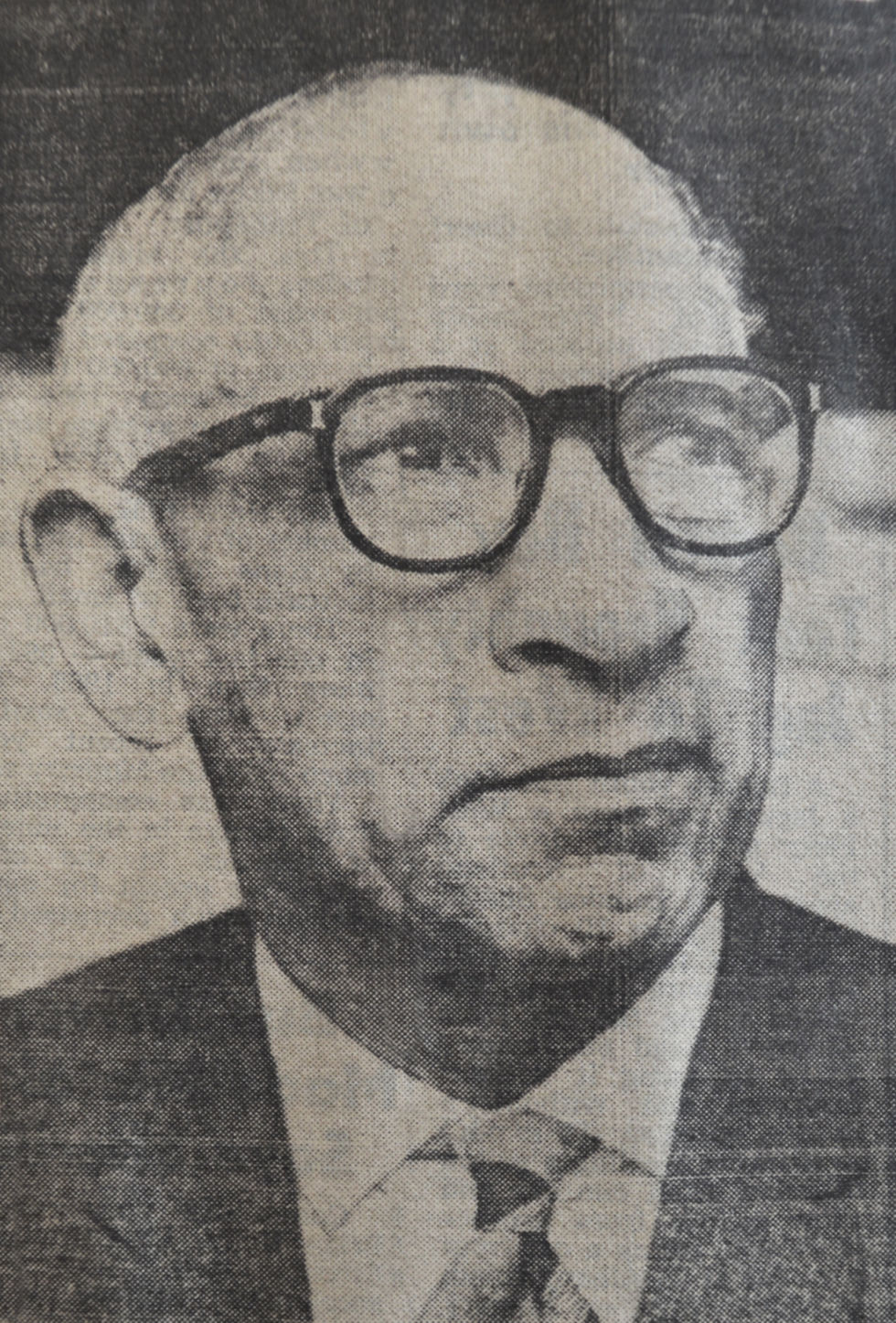Dr Jainti Dass Saggar - Part One
- woventogetherdundee

- Mar 1, 2022
- 6 min read
Updated: Aug 7, 2023

For more than a century, the pursuit of university and higher education has been a key factor in bringing people to Dundee. While for some their stay in the city would be short, for others it would remain home for the rest of their life. Dundee is indeed fortunate that Dr Jainti Das Saggar falls into the latter group, for few others can claim to have made the impact that he did on his new home. As a popular and dedicated local doctor he won the admiration and respect of his patients through his care and hard work. As a councillor, he made a major contribution to the governance of Dundee and worked hard for those he represented. Today his name lives on in many ways, including in Saggar Street, off City Road, which was named in tribute to him.
Jainti was born in India in 1898 and was the son of Ram Saran Dass Saggar. After studying at Lahore Medical College, he arrived in Dundee to matriculate at University College, Dundee (UCD) for the start of the 1920-21 session, reportedly having journeyed from India to Scotland in 1919. The matriculation register suggests another student from the same college, Ram Parshad Sood, matriculated at the same time, suggesting the two had made the long journey to Dundee together. Regardless, they would certainly know each other well when in Dundee. In addition to both studying Medicine, they played together in the UCD hockey team’s 2nd XI and, as we shall see, both were involved with the Dundee Indian Association. It is also likely that shared similar political views, with Sood participating in the Dundee Parliament, a political debating society, as a Labour member.
At this time UCD was part of the University of St Andrews and since the early years of the 20th century had been attracting a small, but growing, cohort of students from the Indian subcontinent. It should be noted that Saggar left Lahore at a time when unrest was increasing in British India, particularly following the brutal Amritsar massacre of 1919, which took place close to Lahore. Lahore itself was the centre of much unrest, and thus the idea of moving to pursue studies abroad would have been an attractive one to many students in the city. Dundee may well have seemed an obvious destination to any Indian student looking to come to the UK at this time. The city had strong links with India and UCD had been founded on the principle that staff and students would face no barriers because of their religion. Whatever the case he proved to be an excellent student. His studies so far meant he entered as a third year student, and after a further three years of study he was awarded the degree of MB ChB in October 1923. He would return to the Medical School to study for a Diploma in Public Health which he received in 1925.
This was by no means the end of the family connection with UCD it its successors. His younger brother, Dhani Ram Saggar, arrived in Dundee to study medicine in 1926, staying with him during his studies. Like Jainti, Dhani would settle in Dundee and have distinguished career as a doctor in the city. Interestingly Dhani seems to have shared his elder brother’s musical talents, for in 1929 he followed him in performing at a concert at Bonnethill UF Church. Jainti’s elder daughter Dr Jean Susheila Saggar, known as Sheila, also followed in her father’s footsteps, starting her studies in Medicine at UCD in 1950 and graduating in 1956 from what had then become Queen’s College, Dundee. The Saggar connection to the University was recognised in 2019 with the establishment of the Jainti Dass Saggar Memorial Scholarship For Excellence, to provide £5,000 for an Indian domiciled student to study at the University.
Jainti was undoubtedly a dedicated student and would go on to be a highly respected and popular doctor, but even in his student days he found time for other interests and demonstrated his talents extended beyond medical ability. He was a good enough hockey player to be selected regularly for the UCD 2nd XI. Singing seems to have been another talent. In September 1922, the Courier recorded that a “novel item” at a concert at Bonnethill UF Church was “the rendering of Hindustani songs by Mr Jainti Dass Saggar”. In 1927, when Dr R P Sood was President of the Dundee Indian Association, Saggar opened its musical evening by singing the Indian National Anthem.
He also got involved in religious matters. In October 1923, days after his graduation, he gave a lecture on Hinduism to the Bible Class of Trinity Congregational Church. This was followed up later that month with his giving a public lecture organised by the Church Guild of the same church on “The Song of Love”. The Courier reported that in this talk he “paid a great tribute to work done by British missionaries in foreign lands”. However on 2 November a letter writer to the same newspaper going by “JMN” who had been present at the “brilliant lecture” noted that this was incorrect. In fact Dr Saggar had argued that most missions failed because “they were not based on the spirit of love and self-sacrifice – the spirit of Christ”. Saggar concluded only three missionaries in history had been based on such a spirit and had succeeded, with only David Livingstone being British. If this report is accurate it is interesting that by implication he did not consider the work of Mary Slessor a success and it is somewhat surprising this did not attract a negative response in Dundee. He would give further talks to the Bible class at Trinity in the next few weeks, suggesting that the church found him to be an effective and stimulating speaker. Later in the 1920s he would speak at spiritualist meetings in Dundee. This is all suggestive of a man of many interests and talents who had quickly established himself a prominent figure in the local community.
After leaving UCD, Jainti soon became a well-known local doctor, moving in 1925 to 8 Byron Street, near the Hilltown, an area he would be associated with throughout his career as GP. In 1926 he made the news when during a Forfarshire Cup tie between Harp and Logie, an accidental collision between two players resulted in a serious injury to a Logie player. As the nearest medical professional, Dr Saggar was summoned to the field and decided that an ambulance should be called and the player taken to Dundee Royal Infirmary for further treatment. Less positive news coverage related to his driving exploits. In March 1927 the trial took place of Adam Key, who in December of the previous year had collided with Dr Saggar’s car while driving a dogcart. While Key was found responsible, and also determined to have been drunk at the time, it emerged that in the six months Dr Saggar had owned his car he had been involved in six accidents. Further evidence that driving was not his greatest skill came in 1928 when after colluding with a cyclist he was found to have been at fault and was fined 30shillings. However this does not seemed to have impacted on his popularity.
By 1930 Dr Saggar’s name was appearing in the local press in connection with his speaking on subjects relating to India to meetings of the Independent Labour Party. The following year he would marry Jane Quinn, whose father was a well-known figure in the local Labour movement. This set the scene for the next chapter of his life in which he would have perhaps his greatest impact on Dundee.
Written by Dr Kenneth Baxter, University of Dundee Archives
Sources
University of Dundee Archive Services, Recs A/162 University College, Dundee Matriculation Register 1917- 1935
The Graduates of University College 1897-1947 (Dundee: University College, Dundee c 1949)
The Courier [and Advertiser], various dates
The Evening Telegraph and Post, various dates
Unpublished talk by Eddie Small, given at the University of Dundee at the launch of Jainti Dass Saggar Memorial Scholarship, 6 December, 2019
Rozina Visram “Saggar, JaintiDass (1898–1954)”, Oxford Dictionary of National Biography (2012)
Information from family members
University of Dundee website - University launches scholarship in honour of Dr Jainti Dass Saggar
Other resources
University of Dundee video - Jainti Saggar - interview with Professor Hopkins 21 Dec 2020




Comments